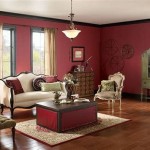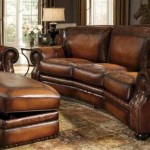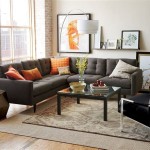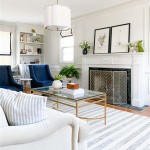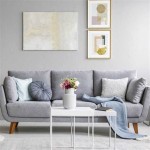Small Living Room Furniture Arrangement Ideas
Arranging furniture in a small living room presents a unique set of challenges. The goal is to maximize space, create a functional layout, and maintain a sense of style and comfort. Effective furniture arrangement can transform a cramped and cluttered room into an inviting and spacious area. Considerations include the room's dimensions, natural light sources, traffic flow, and the primary function of the space. Careful planning and strategic furniture placement are crucial for achieving an optimal small living room design.
Before moving any furniture, it is essential to assess the room. Measure the length and width of the space, noting the location of windows, doors, fireplaces, and electrical outlets. This information will help determine the best placement for larger pieces of furniture, such as sofas and entertainment centers. Consider the architectural features of the room and how they might influence the arrangement. For example, a large window with a scenic view might serve as a focal point, while a fireplace may dictate the positioning of seating arrangements.
Next, determine the primary function of the living room. Is it primarily used for relaxation, entertainment, or socializing? The function will influence the type of furniture needed and how it should be arranged. For example, a living room primarily used for watching television will require a comfortable seating arrangement facing the TV, while a living room used for socializing may benefit from a more conversational layout with multiple seating options.
Prioritizing Furniture Selection for Small Spaces
Choosing the right furniture is paramount for a small living room. Opt for pieces that are appropriately scaled to the size of the room. Avoid oversized sofas and bulky chairs that can overwhelm the space. Instead, consider smaller sofas, loveseats, or sectionals that can be configured to fit the room's dimensions. Modular furniture offers versatility and can be rearranged as needed. Select furniture with clean lines and a minimalist design to avoid visual clutter.
Multi-functional furniture is particularly useful in small living rooms. Consider items that serve multiple purposes, such as a coffee table with built-in storage, an ottoman that can be used as a footrest or extra seating, or a sofa bed for accommodating guests. These pieces help maximize space and reduce the need for additional furniture. When choosing a coffee table, consider one with a lift-top mechanism that can be used as a makeshift dining table or workspace. Storage ottomans provide a discreet way to store blankets, books, or other items, keeping the room tidy and organized.
Wall-mounted shelves and floating cabinets are excellent storage solutions for small living rooms. They utilize vertical space without taking up valuable floor space. Bookshelves can be used to display books, decorative items, and plants, adding visual interest to the room. Floating cabinets can be used to store media equipment, games, or other items, keeping them out of sight and reducing clutter. Ensure that shelves and cabinets are securely mounted to the wall and can support the weight of the items they will hold.
Mirrors are valuable tools for creating the illusion of space in a small living room. They reflect light and make the room appear larger than it actually is. Consider placing a large mirror on a prominent wall or using multiple smaller mirrors to create a gallery wall. Mirrors can also be used to enhance natural light by reflecting it into darker corners of the room. Position mirrors strategically to avoid reflecting clutter or undesirable views.
Color plays a significant role in the perception of space. Light and neutral colors tend to make a room feel larger and more open, while dark colors can make it feel smaller and more enclosed. Consider painting the walls in a light color, such as white, off-white, or a pale pastel. Use pops of color in accessories, such as throw pillows, rugs, and artwork, to add visual interest without overwhelming the space.
Optimizing Furniture Arrangement Techniques
Once the appropriate furniture has been selected, the next step is to arrange it in a way that maximizes space and creates a functional layout. Start by identifying the focal point of the room. This could be a window with a view, a fireplace, or a television. Arrange the furniture around the focal point, creating a comfortable and inviting seating area.
The placement of the sofa is crucial in a small living room. Position it against the longest wall in the room to maximize floor space. If the room is narrow, avoid placing the sofa perpendicular to the length of the room, as this can create a visual barrier and make the space feel smaller. Consider floating the sofa in the center of the room to create distinct zones if the layout allows. This can help define the seating area and create a sense of separation from other areas of the room.
Create a clear traffic flow by arranging furniture in a way that allows for easy movement throughout the room. Avoid blocking doorways or creating obstacles that people have to navigate around. Leave adequate space between furniture pieces to allow for comfortable passage. Consider using rugs to define the seating area and create a sense of cohesion. Choose rugs that are appropriately sized for the room and that complement the color scheme.
Layering is a technique used to add depth and interest to a room. This involves combining different textures, patterns, and colors to create a visually appealing space. Use a variety of throw pillows, blankets, and rugs to add texture to the seating area. Incorporate plants and artwork to add color and visual interest. Layering should be done carefully to avoid overwhelming the room. The goal is to create a balanced and cohesive look that enhances the overall design.
Lighting is essential for creating a comfortable and inviting atmosphere in a small living room. Use a combination of natural light, overhead lighting, and task lighting to illuminate the space. Maximize natural light by keeping windows clean and uncluttered. Use sheer curtains or blinds to filter the light without blocking it completely. Add table lamps and floor lamps to provide task lighting for reading or other activities. Consider using dimmer switches to adjust the brightness of the lights and create different moods.
Maximizing Space with Specific Layout Strategies
Several specific layout strategies can be employed to maximize space in a small living room. One common approach is to create a conversational layout, where seating is arranged around a central coffee table to encourage interaction. This layout is ideal for living rooms that are primarily used for socializing. The seats can be arranged in L shape, facing each other, promoting conversation.
Another strategy is to create a media-focused layout, where seating is arranged around a television or entertainment center. This layout is ideal for living rooms that are primarily used for watching movies or playing video games. Ensure that the seating is comfortable and that the television is positioned at a comfortable viewing distance. Consider using a wall-mounted television to save floor space.
For small, narrow living rooms, consider using a gallery wall to draw the eye upwards and create the illusion of height. Hang a collection of artwork, photographs, or decorative items on the wall to create a focal point. Use frames of varying sizes and styles to add visual interest. Ensure that the gallery wall is well-lit to highlight the artwork and draw the eye upwards.
In small apartments or studio apartments where the living room serves multiple functions, such as a living room and bedroom, consider using room dividers to create separate zones. Room dividers can be used to delineate the sleeping area from the living area, providing privacy and creating a sense of separation. Consider using curtains, screens, or bookshelves as room dividers. Ensure that the room divider is lightweight and easy to move so that it can be adjusted as needed.
Finally, decluttering is essential for maximizing space in a small living room. Remove any unnecessary items that are taking up space and creating visual clutter. Store items that are not frequently used in storage containers or in another room. Keep surfaces clean and organized. A clutter-free living room will feel larger, more open, and more inviting.
By carefully considering these furniture arrangement ideas, it is possible to create a functional, stylish, and comfortable small living room. The foundation of a successful design lies in thoughtful planning, strategic furniture choices, and a commitment to maximizing space and minimizing clutter. The end result is a sanctuary that reflects personal style and provides a relaxing and inviting environment.

Ideas For Small Living Room Furniture Placement Renovation Apartment Remodel

How To Arrange Furniture In A Small Living Room Rooms Layout

How To Efficiently Arrange The Furniture In A Small Living Room

How To Efficiently Arrange The Furniture In A Small Living Room

Small Living Room Layout Ideas

Small Living Room Solutions For Furniture Placement Layout Design Casual Rooms

Small Living Room Furniture Arrangement Ideas Design Cafe

How To Arrange A Living Room With Fireplace House Of Hipsters

Small Living Room Furniture Arrangement Ideas Design Cafe

Living Room Furniture Layout Ideas For Small Spaces Beautiful Homes


